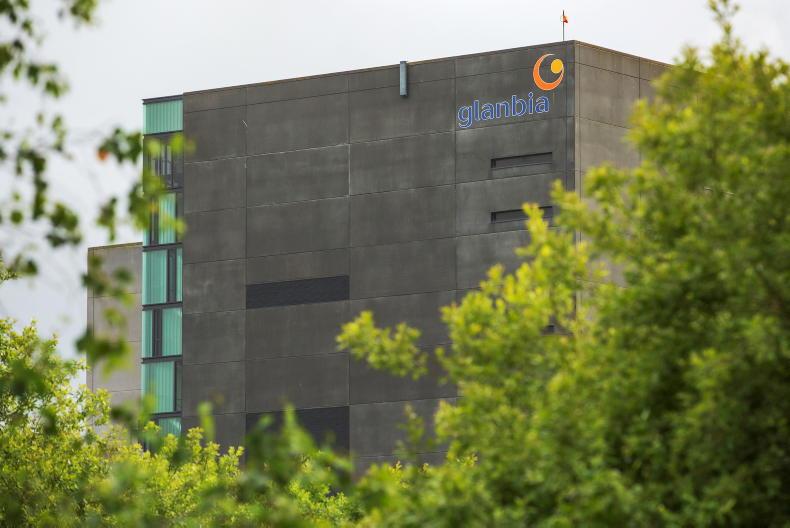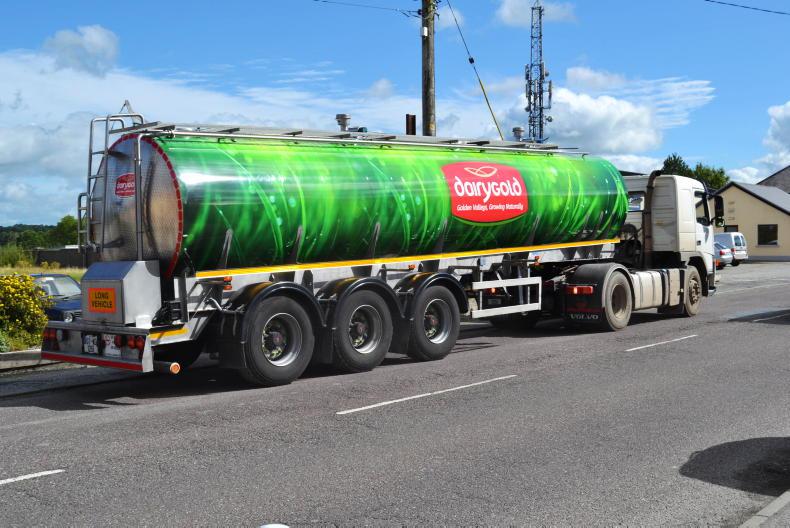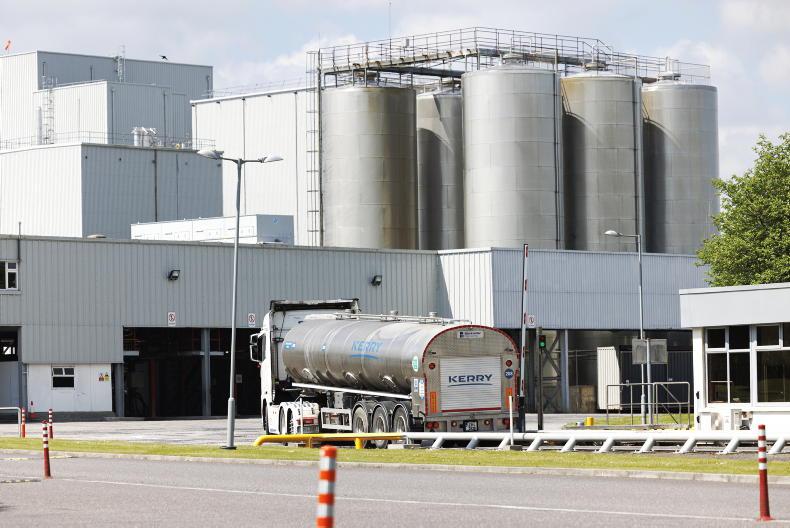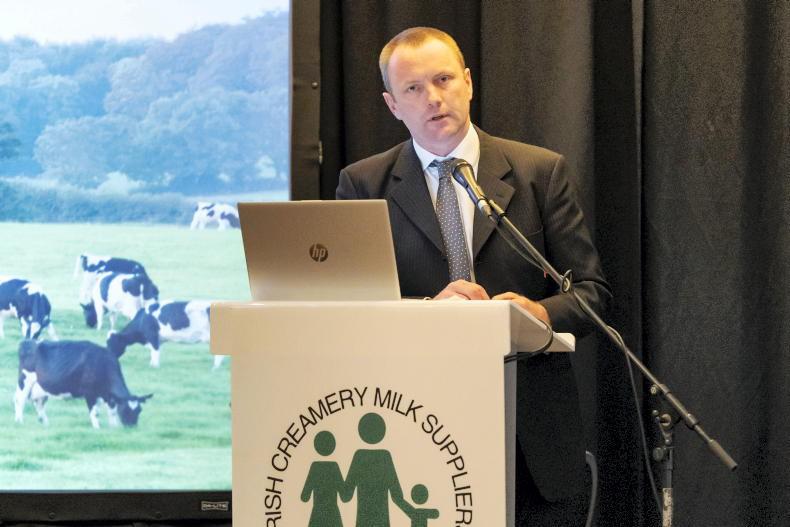The full implications of the announcement by Glanbia Ireland to penalise farmers who have increased milk production won’t be known for some time to come. Farmers are looking for immediate solutions to what will be a severe financial penalty for many. Some of the options are discussed here.
The average Glanbia milk supplier produces 39% of their milk in the peak months of April, May and June. If a supplier produces additional milk over and above their allowance, that new milk will be paid 30% less than the prevailing milk price at the time.
According to ICBF data, the average milk price paid to Glanbia suppliers over the last five years was 35.08c/l. Based on that milk price and the existing milk supply curve, all new milk supplied to Glanbia, before the 2.5% and 5% annual allowance is factored in, will be hit with a minimum 4.1c/l reduction compared to existing milk supplies. That’s based on 39% of the new milk getting a 30% hit, which equates to 11.7% of all new milk supplied.
Case study A
A typical Glanbia farmer with 120 cows and selling 600,000l today and who plans to increase to 140 cows and sell 700,000l would be deducted €3,489 in 2022. This minimum penalty decreases to €2,857 in 2023 and €2,210 in 2024. This is after taking the 2.5% annual compound increase in supply permitted under the scheme. The extra payment for December to February would amount to approximately €730 for a farmer of this scale with similar milk supply curve. However, farmers are getting most of this bonus already.
Case study B
A tillage and drystock farmer who is a member of Glanbia Co-Op decides to convert his 200 acre farm to dairy and to milk 200 cows with a projected milk supply of 1m litres annually. Because he is a member of the Co-Op, he is given a milk supply agreement and is permitted to produce up to 550,000l without any penalty provided that his peak milk supply is in line with the Glanbia average. Glanbia will not accept any additional volume over and above the 2.5% annual increase at peak. This effectively caps cow numbers for new entrants and new units at 100 to 110 cows for the duration of the scheme.
Case study C
A 30-year-old dairy farm manager in the Glanbia region has been saving up money and building up dairy youngstock numbers to establish his own dairy herd in 2022. This young farmer is not a co-op member and so Glanbia will not accept his milk for the duration of this scheme.
Adjusting the milk supply curve away from the Moorepark blueprint to avoid peak penalties and take advantage of off-peak bonuses is a major long-term decision for any farmer to make and on the face of it, would not pay you to do so.
Furthermore, it would take a number of years to implement a change to calving pattern and given that Glanbia says the new measures are only to run until the end of 2024, it’s a very drastic action with little or no benefits.
Teagasc research has shown that split calving (50% of herd calving in February to April and 50% calving in September to November) can reduce the peak supply by 2.8% compared to spring calving and 100% autumn calving reduces peak production by 5.4%. This is because cows that calve in the autumn and winter are still milking well in early summer.
Teagasc analysis also shows that split or spread out calving patterns increase workload on farms by four hours per cow per year. Furthermore, the direct profitability of these systems is less than spring-calving systems to the tune of 1.6c/l. Drastic changes to the calving patterns of extra cows will not negate a herd from producing more milk at peak. It will increase workload, increase costs and reduce profitability.
Moving mean calving date from mid-February to mid-January will be less profitable for dairy farmers and have negligible impacts on reducing exposure in the Glanbia scheme. The Irish Farmers Journal understands that each of the peak months are being treated separately. So if a farmer moves calving date forward it is likely that the peak will move from May to April and because April supply will be higher than the reference period a penalty will incur. There is no incentive for being below the reference year in May or June.
Case study D
A farmer has invested in land and buildings to milk an extra 100 cows in 2022. He has decided to put 50% of these extra cows in calf for the autumn. Rather than producing 195,000l in peak, he will now produce 181,000l in peak. If all of the extra milk produced at peak was subject to the penalty, moving to split calving would reduce the fine from to €20,521 to €19,048.
More milk would be subject to the December and January bonus of 4c/l, with 16% of total supply typically produced in these months, amounting to €3,200 in extra revenue, which reduces the fine to €15,848. However, the profitability of split or spread out calving is 1.6c/l behind spring calving amounting to €8,000 in this example, meaning the farmer would be worse off by splitting the calving date in the extra cows.
Case study E
A farmer has invested in land and buildings to milk an extra 100 cows in 2022. He has decided to calve all of these cows in the autumn. Rather than producing 195,000l at peak, he will now produce 168,000l at peak. This will reduce his fine from €20,521 to €17,680. If he produces 29% of total annual supply in December and January and gets the bonus of 4c/l it will bring in an extra €5,720 while the February bonus of 3c/l will bring in €2,100 which further reduces his penalties to €9,860. However, the profit per litre in autumn calving is 1.6c/l poorer than spring so the net cost of moving to autumn calving on the extra cows would be €17,860, which is €2,600 less worse off than spring calving. But that’s not accounting for the extra workload and facilities required when split calving.
Farmers who are not expanding or have not expanded since the reference years have little to fear from the new restrictions. However, certain things might catch people out, even if they are not necessarily increasing cow numbers. For example, herds that are maturing are going to milk more and there are natural productivity increases due to genetics, feeding, etc.
Farms that produce more than 550,000l per year will not be eligible for the 2.5% annual increase if their supply profile is greater than 39% at peak. Half the herds in Glanbia produce more than 550,000l and half the herds produce more than 39% in the peak months so a significant number of farmers will be affected by this measure.
Essentially, it is new entrants and expanding farmers that will be worst affected by these measures.
Other than not milking cows during peak, there is no way of avoiding increasing the peak supply. All they can really do is reduce cow numbers and not produce the milk or reduce their exposure to the penalties. These measures may help to reduce exposure:
During the summer months the response to concentrate feeding is approximately 0.7kg of milk per 1kg of meal. So reducing meal feeding from 2kg/day to zero will reduce milk production by 1.4kg/day. For a herd producing 26l/cow/day at peak this is a reduction of 5%. Feeding milk replacer to calves instead of whole milk in spring will reduce the percentage of milk supplied at peak but will generally not reduce the volume of milk supplied. Milking cows once per day (OAD) will reduce milk yield per cow by 30% and reduce milk solids by 20% during the period on once a day. Previous research has shown that subsequent lactation yield can be affected, but this depends on the duration of OAD and the stage of lactation the cows were at when they went on OAD.Farms that increase milk supply may be able to reduce their exposure to Glanbia penalties by putting some or all of the herd on OAD for a period during each of the peak months to reduce their overall exposure. This might entail milking once a day for one week and twice a day for the next, or some variation of that. An increase in mastitis and SCC can be expected if this rather depressing measure is to be employed.
Breeding for low volume and high solids cows with a flatter and more persistent lactation curve will help to avoid producing more volume at peak. However, this is a very long-term strategy but one which could have benefits for the industry.
The full implications of the announcement by Glanbia Ireland to penalise farmers who have increased milk production won’t be known for some time to come. Farmers are looking for immediate solutions to what will be a severe financial penalty for many. Some of the options are discussed here.
The average Glanbia milk supplier produces 39% of their milk in the peak months of April, May and June. If a supplier produces additional milk over and above their allowance, that new milk will be paid 30% less than the prevailing milk price at the time.
According to ICBF data, the average milk price paid to Glanbia suppliers over the last five years was 35.08c/l. Based on that milk price and the existing milk supply curve, all new milk supplied to Glanbia, before the 2.5% and 5% annual allowance is factored in, will be hit with a minimum 4.1c/l reduction compared to existing milk supplies. That’s based on 39% of the new milk getting a 30% hit, which equates to 11.7% of all new milk supplied.
Case study A
A typical Glanbia farmer with 120 cows and selling 600,000l today and who plans to increase to 140 cows and sell 700,000l would be deducted €3,489 in 2022. This minimum penalty decreases to €2,857 in 2023 and €2,210 in 2024. This is after taking the 2.5% annual compound increase in supply permitted under the scheme. The extra payment for December to February would amount to approximately €730 for a farmer of this scale with similar milk supply curve. However, farmers are getting most of this bonus already.
Case study B
A tillage and drystock farmer who is a member of Glanbia Co-Op decides to convert his 200 acre farm to dairy and to milk 200 cows with a projected milk supply of 1m litres annually. Because he is a member of the Co-Op, he is given a milk supply agreement and is permitted to produce up to 550,000l without any penalty provided that his peak milk supply is in line with the Glanbia average. Glanbia will not accept any additional volume over and above the 2.5% annual increase at peak. This effectively caps cow numbers for new entrants and new units at 100 to 110 cows for the duration of the scheme.
Case study C
A 30-year-old dairy farm manager in the Glanbia region has been saving up money and building up dairy youngstock numbers to establish his own dairy herd in 2022. This young farmer is not a co-op member and so Glanbia will not accept his milk for the duration of this scheme.
Adjusting the milk supply curve away from the Moorepark blueprint to avoid peak penalties and take advantage of off-peak bonuses is a major long-term decision for any farmer to make and on the face of it, would not pay you to do so.
Furthermore, it would take a number of years to implement a change to calving pattern and given that Glanbia says the new measures are only to run until the end of 2024, it’s a very drastic action with little or no benefits.
Teagasc research has shown that split calving (50% of herd calving in February to April and 50% calving in September to November) can reduce the peak supply by 2.8% compared to spring calving and 100% autumn calving reduces peak production by 5.4%. This is because cows that calve in the autumn and winter are still milking well in early summer.
Teagasc analysis also shows that split or spread out calving patterns increase workload on farms by four hours per cow per year. Furthermore, the direct profitability of these systems is less than spring-calving systems to the tune of 1.6c/l. Drastic changes to the calving patterns of extra cows will not negate a herd from producing more milk at peak. It will increase workload, increase costs and reduce profitability.
Moving mean calving date from mid-February to mid-January will be less profitable for dairy farmers and have negligible impacts on reducing exposure in the Glanbia scheme. The Irish Farmers Journal understands that each of the peak months are being treated separately. So if a farmer moves calving date forward it is likely that the peak will move from May to April and because April supply will be higher than the reference period a penalty will incur. There is no incentive for being below the reference year in May or June.
Case study D
A farmer has invested in land and buildings to milk an extra 100 cows in 2022. He has decided to put 50% of these extra cows in calf for the autumn. Rather than producing 195,000l in peak, he will now produce 181,000l in peak. If all of the extra milk produced at peak was subject to the penalty, moving to split calving would reduce the fine from to €20,521 to €19,048.
More milk would be subject to the December and January bonus of 4c/l, with 16% of total supply typically produced in these months, amounting to €3,200 in extra revenue, which reduces the fine to €15,848. However, the profitability of split or spread out calving is 1.6c/l behind spring calving amounting to €8,000 in this example, meaning the farmer would be worse off by splitting the calving date in the extra cows.
Case study E
A farmer has invested in land and buildings to milk an extra 100 cows in 2022. He has decided to calve all of these cows in the autumn. Rather than producing 195,000l at peak, he will now produce 168,000l at peak. This will reduce his fine from €20,521 to €17,680. If he produces 29% of total annual supply in December and January and gets the bonus of 4c/l it will bring in an extra €5,720 while the February bonus of 3c/l will bring in €2,100 which further reduces his penalties to €9,860. However, the profit per litre in autumn calving is 1.6c/l poorer than spring so the net cost of moving to autumn calving on the extra cows would be €17,860, which is €2,600 less worse off than spring calving. But that’s not accounting for the extra workload and facilities required when split calving.
Farmers who are not expanding or have not expanded since the reference years have little to fear from the new restrictions. However, certain things might catch people out, even if they are not necessarily increasing cow numbers. For example, herds that are maturing are going to milk more and there are natural productivity increases due to genetics, feeding, etc.
Farms that produce more than 550,000l per year will not be eligible for the 2.5% annual increase if their supply profile is greater than 39% at peak. Half the herds in Glanbia produce more than 550,000l and half the herds produce more than 39% in the peak months so a significant number of farmers will be affected by this measure.
Essentially, it is new entrants and expanding farmers that will be worst affected by these measures.
Other than not milking cows during peak, there is no way of avoiding increasing the peak supply. All they can really do is reduce cow numbers and not produce the milk or reduce their exposure to the penalties. These measures may help to reduce exposure:
During the summer months the response to concentrate feeding is approximately 0.7kg of milk per 1kg of meal. So reducing meal feeding from 2kg/day to zero will reduce milk production by 1.4kg/day. For a herd producing 26l/cow/day at peak this is a reduction of 5%. Feeding milk replacer to calves instead of whole milk in spring will reduce the percentage of milk supplied at peak but will generally not reduce the volume of milk supplied. Milking cows once per day (OAD) will reduce milk yield per cow by 30% and reduce milk solids by 20% during the period on once a day. Previous research has shown that subsequent lactation yield can be affected, but this depends on the duration of OAD and the stage of lactation the cows were at when they went on OAD.Farms that increase milk supply may be able to reduce their exposure to Glanbia penalties by putting some or all of the herd on OAD for a period during each of the peak months to reduce their overall exposure. This might entail milking once a day for one week and twice a day for the next, or some variation of that. An increase in mastitis and SCC can be expected if this rather depressing measure is to be employed.
Breeding for low volume and high solids cows with a flatter and more persistent lactation curve will help to avoid producing more volume at peak. However, this is a very long-term strategy but one which could have benefits for the industry. 









SHARING OPTIONS